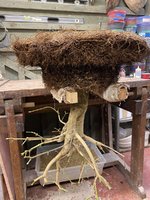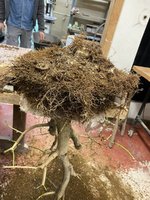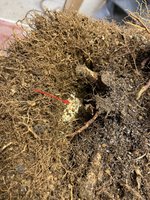BobbyLane
Imperial Masterpiece
Are you sure thats not beaver damage

next time i try a layer ill be sure to whip out the knob cutters!
Are you sure thats not beaver damage

When you get enough new (adventitious) roots, they could support the part of the tree above the girdle. The original roots could then starve to death and nothing else would be lost. But, if there are problems generating enough adventitious roots, the whole works could be lost.So the new roots ( layer) aren’t contributing to the starch grains? Or they are not making enough to sustain the tree?
One can snip off parts of plants (usually branch tips or pieces of the stems near the tips) and stick them in some medium. That 'cutting' (as it is called) may generate adventitious roots and become a new tree, but doing it is a race against time. Some water is lost to photosynthesis and transpiration which desiccate the cutting. The cutting must generate adventitious roots before it desiccates! Hence cuttings are kept in a terrarium-like environment to minimize how much water is lost by transpiration.Another question. For the examples of the”big cutting”, is the remaining part of the trunk just holding the tree in place so the roots don’t get jostled and break off?
That green is such a nice color.So far......so good??? I think I’m gonna let it grow and grow......more roots.
View attachment 376046
I was just going to say the same thing, like it's glowing.That green is such a nice color.
Got mine from Superfly.Your maple is looking healthy and vigorous.
View attachment 376075
@ABCarve , this is a homemade cutting tool no? From what was it made?
So this is the tree I was referring to when I said "the big cutting". This is a pals Hokkaido elm. It was 11.5" high with a bad nebari and he wanted to make it a shohin. He didn't want to wait on a ground layer and simply sawed the entire trunk off so it was 8.5" high. The trunk is about 2.5" in caliper. This was done in late winter just as the tree was waking up, in the environment of a temperate greenhouse. The trees bottom end was soaked in KLN rooting liquid then placed in a tray of orchid moss. The whole thing was then placed on a heating mat. Within two monthsit was cutback. The second photo is what the stump became. I think they call this a twofer.When you get enough new (adventitious) roots, they could support the part of the tree above the girdle. The original roots could then starve to death and nothing else would be lost. But, if there are problems generating enough adventitious roots, the whole works could be lost.
One can snip off parts of plants (usually branch tips or pieces of the stems near the tips) and stick them in some medium. That 'cutting' (as it is called) may generate adventitious roots and become a new tree, but doing it is a race against time. Some water is lost to photosynthesis and transpiration which desiccate the cutting. The cutting must generate adventitious roots before it desiccates! Hence cuttings are kept in a terrarium-like environment to minimize how much water is lost by transpiration.
With an air layer, the xylem is left intact, supplying water and nutrients to the foliage which, in turn, keeps making auxin to stimulate root growth and carbohydrates to fuel it.
A cutting has no water supply.
Water is supplied to a layer (via xylem/wood).
IOW, that stuff you like to carve, AB, is a water line.
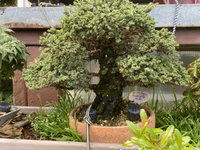
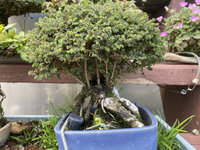
Yep. One could probably do the same with most any ulmus. They will sprout from root cuttings and stem cuttings can be rooted. One can also do as you have done with your full-moon maple and get an ulmus two-fer. But I think I can pretty much guarantee that it ain't gonna happen with your full-moon. If there is not a node below the girdle, the (now) roots will die - it is just a question of whether it is before the part you want has sufficient adventitious roots to survive before that happens.So this is the tree I was referring to when I said "the big cutting". This is a pals Hokkaido elm. It was 11.5" high with a bad nebari and he wanted to make it a shohin. He didn't want to wait on a ground layer and simply sawed the entire trunk off so it was 8.5" high. The trunk is about 2.5" in caliper. This was done in late winter just as the tree was waking up, in the environment of a temperate greenhouse. The trees bottom end was soaked in KLN rooting liquid then placed in a tray of orchid moss. The whole thing was then placed on a heating mat. Within two monthsit was cutback. The second photo is what the stump became. I think they call this a twofer.
View attachment 380525View attachment 380526
